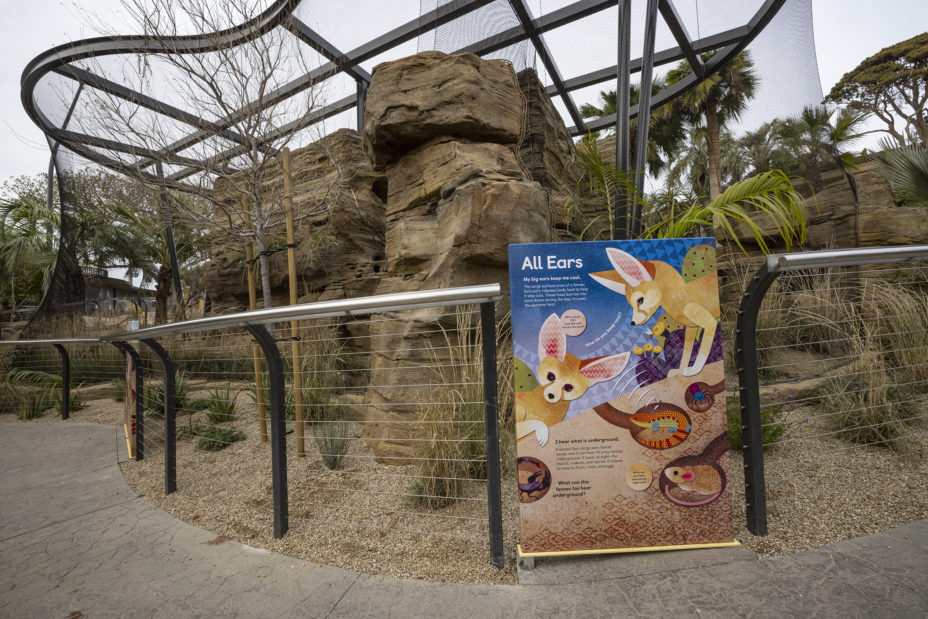San Diego Zoo Wildlife Alliance Prepares to Open Denny Sanford Wildlife Explorers Basecamp at the San Diego Zoo
The past couple of months, burrowing owls and prairie dogs at the San Diego Zoo moved to their new “digs” in the Denny Sanford Wildlife Explorers Basecamp. Orb weaver spiders began spinning new webs, and other wildlife like Fijian iguanas, axolotls and dragon-headed katydids are now acclimating to their new habitats in preparation for the public opening March 2022. The public ribbon-cutting ceremony to open Wildlife Explorers Basecamp will take place at 9:30 a.m., Friday, March 11, 2022, hosted by Paul A. Baribault, president and chief executive officer of San Diego Zoo Wildlife Alliance. Admission for Basecamp is included with admission to the San Diego Zoo.
Wildlife Explorers Basecamp is designed to bring guests and their families up close to nature, and offer interactive play opportunities on oversized, species-themed sculptures. This new area of the San Diego Zoo offers visitors special sensory elements for a multifaceted engagement approach, with microscopes and touch screens, plus animation and dynamic lighting installation in the new buildings.
Constructed on the site of the former Children’s Zoo, Wildlife Explorers Basecamp is designed to appeal to a broader audience while still maintaining its place in the hearts of young explorers. The common element underscoring the play and learning opportunities at Basecamp is nurturing the future caretakers of the planet.
The 3.2 acres of Basecamp are divided into four types of habitats, featuring the wildlife that live in these areas— Rainforest, Wild Woods, Marsh Meadows and Desert Dunes.
The Rainforestarea of Basecamp is centered around the 10,000-square-foot McKinney Family Spineless Marvels, building featuring arachnids, a coconut crab habitat and a real-life beehive with a larger-than-life honeycomb, inviting young guests to become the bee. And at the neighboring Rady Ambassadors Headquarters, guests will encounter a range of animals from all over the planet, including a two-toed sloth and a prehensile-tailed porcupine.
Wild Woods is an area for wildlife species including coatis and features the impressive Prebys Foundation Discovery Bridge and 20-foot tall structure designed to look like an ancient oak tree. This dynamic nature-play tree structure offers multiple points of access for guests—from a suspension bridge and net tunnel to a spiral staircase in the middle—and provides a parallel-play experience, because it is adjacent to the squirrel monkey habitat. Water-play extends into this woodland-themed area, with a waterfall grotto and splash pad, water jets and a stream—plus, a bluff area with a boulder scramble at the side, for exploration.
Marsh Meadows is designed with an array of plant life designed to evoke a variety of habitats, such as marshes, swamps and estuaries that affect the health of our planet.An outdoor watery habitat, pathways include silhouettes of kid-size frogs and fish to help convey the idea that guests are inhabiting the marsh along with the wildlife that live here. Included in this area is the Art and Danielle Engel Cool Critters building – a two-story herpetology and ichthyology structure that offers 7,000 square feet of immersive environments, digital media, learning opportunities and educational classroom spaces created to engage guests of all ages. The wildlife here includes snakes, amphibians, crocodilians, turtles and lizards, including endangered Fijian iguanas.
Desert Dunes, a dry desert wash-themed area, takes center stage in this part of Wildlife Explorers Basecamp, with boulder play opportunities for climbing, scrambling, hopping and more. Hidden reptile sculptures and petroglyphs can be found among the rocks and cool caves that offer shaded areas for guests to beat the heat, like their desert wildlife counterparts—including the fennec fox, prairie dog and burrowing owl.

Category: Animals, Architecture, Donations, Education, Entertainment, Events, Local News, Nonprofit, Plants







